[Editor’s Note: This decade has witnessed a revolution in warfighting with the proliferation of battlefield automation and the concurrent race to develop effective countermeasures. Constellations of inexpensive, expendable, small armed Unmanned Aerial Vehicles (UAVs) in the hands of dismounted infantry are penetrating the airspace above fixed defensive lines and attriting exquisite, expensive, and finite combat systems (i.e., Main Battle Tanks [MBTs], air defense complexes, artillery, and counter-battery radar systems).
These UAVs are constantly evolving, forcing rapid innovation across small windows of time, yielding fleeting opportunities of advantage. According to Ukraine’s Deputy Minister of Digital Transformation, “What is flying today won’t be able to fly tomorrow.”
In today post, Army Mad Scientist explores how this UAV/Counter-Unmanned Aerial System (C-UAS) fight continues to transform Twenty-first century warfighting and wrestles with the associated implications for the U.S. Army by posing five challenging questions — Read on!]
Harbinger of the Future: The Second Nagorno-Karabakh Conflict (27 Sep – 10 Nov 2020)
The February 2021 edition of the TRADOC G-2’s OE Watch [republished on this blog site here] presented a Russian post-mortem on Armenia’s Russian-supplied Air Defenses that had been gutted by Azerbaijan strikes employing Turkish-supplied Bayraktar TB2 Unmanned Aerial Vehicles (UAVs) and Israel-supplied IAI Harop (or Harpy 2) Loitering Munitions (LMs). Per Samvel Babayan, former Secretary of the Security Council of the Nagorno-Karabakh Republic, “… on the first day of the war on 27 September… Armenians in Karabakh lost up to 50 percent of their air defense systems and 40 percent of their artillery from Azerbaijani strikes…”

“A number of Russian sources … reported that specialists from the Military Academy of the Air Defense Forces of Russia conducted a thorough analysis of the large-scale losses of Armenian air defense systems in Nagorno-Karabakh and the almost complete dominance of Turkish unmanned aerial vehicles (UAVs)…. Apparently, the issue was a low radar cross-section of Turkish UAVs, which did not enable enough time to detect them, giving them an opportunity to successfully open fire,” said one of the sources.… the sources stated results of field tests of [Russian] air defense systems, including the Buk-M1, the Tor-M1, Osa-AKM, Pantsir-S1 and Tunguska-M1, and reportedly show their low efficiency when operating against small UAVs with a radar cross-section of less than 0.01 square meters…” — Armenian news article entitled Уроки Карабаха: могут ли российские средства ПВО противостоять беспилотникам (Lessons of Karabakh: can Russian air defense systems counter unmanned aerial vehicles),” News.am (Armenian news website based in Yerevan), 22 December 2020. https://news.am/rus/news/620332.html
Democratization of the Air Domain: Rise of UAVs and LMs
We interviewed proclaimed Mad Scientist COL Scott Shaw, the final Commander of the U.S. Army’s Asymmetric Warfare Group (AWG), in March 2021 to discuss the future of ground warfare and the realities of combat for today’s Soldiers. One of his most salient points addressed the advent of UAVs for reconnaissance and targeting, observing that as these systems proliferate, they will lower the “entry fee” into combined arms operations, granting even non-state actors a localized air force and creating a general environment of fear.
One month later, Army Mad Scientist interviewed COL John Antal (USA-Ret.) who observed that the battlefield is becoming increasingly Transparent. During the brief Second Nagorno-Karabakh Conflict, Armenian command posts and air defense assets were easily targeted and destroyed — “If you are sensed, you are targeted; and if targeted, you are destroyed or rendered inop. Sensors are more important than shooters, enabling shooters to now execute with greater precision than ever before.” High-definition full motion real-time videos from UAVs not only allowed Azerbaijan to target and destroy Armenian systems and personnel, but provided intelligence, battle damage assessment, and video content used to win the information war. On the 21st Century Battlefield, “there is nowhere to hide.”
COL Antal also observed that “Top Attack is Becoming the Decisive Method of War.” Azerbaijan’s UAVs and LMs provided them with a relatively inexpensive substitute for conventional air power. “Any state (or non-state actor) with the resources to purchase top attack systems on the global market has the potential to achieve air supremacy.”
Russia’s War in Ukraine – The Proliferation of UAVs
During the past 26 months of Russia’s “Special Military Operation” (SMO) in Ukraine, we’ve seen Russia and Ukraine employ vast numbers of diverse types of UAVs, including:
-
-
 Intelligence, Surveillance, and Reconnaissance (ISR) systems, providing real-time forward observation, fires direction and adjustment, and cueing of strike systems. These systems are also serving as communications relays for other UAVs (like the Russian Orlan-30, shown to the right);
Intelligence, Surveillance, and Reconnaissance (ISR) systems, providing real-time forward observation, fires direction and adjustment, and cueing of strike systems. These systems are also serving as communications relays for other UAVs (like the Russian Orlan-30, shown to the right);
-
-
-
 LMs, programmed to surveil an area and strike prioritized target sets (like the Russian Lancet-3, shown to the right);
LMs, programmed to surveil an area and strike prioritized target sets (like the Russian Lancet-3, shown to the right);
-
-
-
- Top attack systems, enabling infantry to engage dismounted,
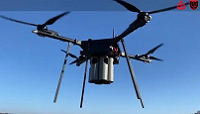 defiladed troops, armored systems, and other targets with dropped munitions (like the Ukrainian quadcopter configured to drop mortar rounds, shown to the right);
defiladed troops, armored systems, and other targets with dropped munitions (like the Ukrainian quadcopter configured to drop mortar rounds, shown to the right);
- Top attack systems, enabling infantry to engage dismounted,
-
-
-
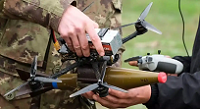 First Person View (FPV) strike systems, enabling hunter-killer teams to destroy targets by delivering munitions via virtual kamikaze strike missions (like the Russian FPV UAV armed with a shaped charge grenade, shown to the right);
First Person View (FPV) strike systems, enabling hunter-killer teams to destroy targets by delivering munitions via virtual kamikaze strike missions (like the Russian FPV UAV armed with a shaped charge grenade, shown to the right);
-
-
-
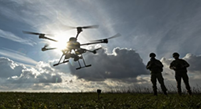 Heavy Bomber systems, enabling the remote emplacement of mines or serving as UAV carriers to extend the range of FPV UAVs (like the Ukrainian Baba Yaga, shown to the right)
Heavy Bomber systems, enabling the remote emplacement of mines or serving as UAV carriers to extend the range of FPV UAVs (like the Ukrainian Baba Yaga, shown to the right)
-
-
-
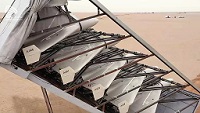 One-Way Attack (OWA) systems, providing accurate, long range strikes at a fraction of the cost of a cruise missile (like the Russian Shahed-136 launcher, shown to the right); and
One-Way Attack (OWA) systems, providing accurate, long range strikes at a fraction of the cost of a cruise missile (like the Russian Shahed-136 launcher, shown to the right); and
-
-
-
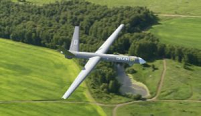 Stand-off strike platforms, remotely piloted aircraft delivering long range precision munitions (like the Russian Orion UAV, shown to the right).
Stand-off strike platforms, remotely piloted aircraft delivering long range precision munitions (like the Russian Orion UAV, shown to the right).
-
Both sides are employing mixed constellations of these systems, operating at varying altitudes, to penetrate and strike targets on and behind the front lines. Observation UAVs are also serving as communications relays that are facilitating deeper strikes into what had been an uncontested space in operational rear areas. Cumulative materiel losses have been staggering, with Russia reportedly having lost more than 3,000 Main Battle Tanks (MBTs) in the past 25 months of war – “more than its entire pre-war active fleet” – with many losses attributed to Ukrainian UAV-directed fires or direct FPV strikes.
Russian Counter-UAS
Russian Electronic Warfare (EW) assets began severely attriting Ukrainian UAVs during the Summer of 2022, with Russian forces reportedly downed nearly 90% of Ukraine’s UAVs as their jamming confused their GPS satellite navigation and severed radio links. Russian EW and jamming efforts initially decreased the survivability of Ukrainian quadcopter UAVs to three flights and fixed-wing UAVs to six flights. As reported by Forbes, per Royal United Services Institute (RUSI) analysts, “in aggregate, only around a third of [Ukrainian] UAV missions can be said to have been successful…. The drone-massacre complicated Ukrainian fire-control, making Ukraine’s artillery batteries less accurate… buying time for Russian troops to reconsolidate in the East and prepare for the Summer’s fighting.”
To counter Ukrainian UAVs, Russia initially relied on a 60km deep belt of EW and air defense assets along its front with Ukrainian forces. Per RUSI, Russia “employed one major EW system per 10km of front, usually situated approximately 7km from the frontline, with more specialized EW capabilities … at higher echelon.” In 2023, these defenses were accounting for the neutralization of “approximately 10,000 [UAF UAVS] a month.”
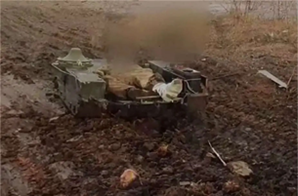
Russia has since been adapting from its dependence on this belt of C-UAS EW defenses to a layered C-UAS capability, with point EW C-UAS defenses being pushed down onto individual combat systems (e.g., individual MBTs and vehicles), small units, and even Unmanned Ground Vehicles (UGVs).
Russia’s Ministry of Defense is also reportedly deploying mechanized C-UAS units, consisting of three vehicles incorporating both kinetic and obscurant defenses — a 6×6 gun-truck mounting a Zu-23-2 23mm twin anti-aircraft gun with a 2000 round per minute rate of fire, a 4×4 utility mounting a 12.7mm heavy machine gun, and a 6×6 truck-mounted modular thermal smoke screen generator.
The Shape of Things to Come…
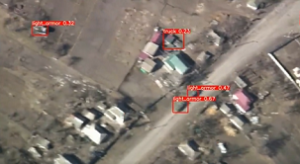
The war in Ukraine represents a “Spanish Civil War” moment in Twenty-first Century Warfare, with both sides driving rapid cycles of innovation, garnering small but fleeting windows of advantage in the UAV / C-UAS fight. First generation UAVs like Ukraine’s Turkish supplied TB-2 Bayraktars and Russia’s Orlan-10s have been swept aside as newer capabilities have been developed and integrated. Extended Reality goggles transformed quadcopters into potent FPV UAVs – empowering individual, dismounted soldiers to deliver precise and inexpensive precision guided munitions onto exquisite and expensive targets. Thermobaric warheads have significantly increased the lethality of these FPV UAVs. Thermal imaging cameras have facilitated night strike operations. Proclaimed Mad Scientist and CNA analyst Sam Bendett recently told Newsweek that both Russia and Ukraine are seeking “to sever the dependence on communication between the drone and the operator, and the drone with a satellite for navigation” – thus overcoming the present dilemma of EW jamming. Artificial Intelligence in the form of machine vision has enabled Ukrainian Armed Force’s Saker Heavy Bomber UAVs to autonomously spot, locate, identify, and select targets automatically – yielding fully autonomous battlefield lethality – and the race is on to integrate this capability into FPV UAVs. In the near future, small units — perhaps even individual soldiers — will be able to deploy swarms of UAVs that will collaborate in conducting coordinated, precision strikes on their objectives – redefining our understanding of mass, shock, and envelopment.
Perhaps most disturbing is the fact that this asymmetric capability will proliferate – to other nations, non-state actors, and individuals (nefarious and otherwise). Just last month, a video was posted on X (formerly Twitter), purportedly showing rebels in Myanmar had 3D-printed a fleet of UAVs in the jungle. This capability is now accessible by anyone, anywhere…
Implications for the U.S. Army
As indicated above, the Russians “learned” an important attribute about this changing character of warfare from the Second Nagorno-Karabakh War. The role of armed UAVs and other automated battlefield capabilities is democratizing, rapidly proliferating and expanding across domains to deliver precision munitions. Russia realized they were behind this revolution in 21st century warfighting, but they couldn’t (initially) adapt and deliver new capabilities until they were already deeply enmeshed in an enduring LSCO in Ukraine and had lost hundreds of thousands of soldiers and several thousands of MBTs and other exquisite combat systems. China, our pacing challenge in the INDO-PACIFIC Region, is watching and learning. They will be much more capable in terms of quantities, range, and precision of battlefield automation — outpacing anything we are observing in Ukraine.
China, our pacing challenge in the INDO-PACIFIC Region, is watching and learning. They will be much more capable in terms of quantities, range, and precision of battlefield automation — outpacing anything we are observing in Ukraine.
How does the U.S. Army move from learning into action and what should we consider?
-
-
- Is there a difference between air defense and C-UAS? The return of SHORAD capabilities to U.S. Army Divisions only addresses part of this threat and not at the scale we are observing in on-going combat operations in Ukraine.
-
-
-
- Nowhere today do we train Soldiers to fight in an Operational Environment populated with constellations of threat UAVs and LMs that we are seeing today. How do we employ our own automated capabilities and train for a threat environment where small armed UAVs and LMs could overwhelm defensive capabilities at the battalion and below level? How do we emulate this threat across homestation and at the Combat Training Centers?
-
-
-
- How do we organize the Army for this capability — to both employ it and defend against it?
 Institutional Force Considerations: Do we need a new proponent for UAVs and C-UAS? Do we need a new branch? What new MOSs should we consider?
Institutional Force Considerations: Do we need a new proponent for UAVs and C-UAS? Do we need a new branch? What new MOSs should we consider?
Operational Force Considerations: Do we need to relook the squad, platoon, and company for C-UAS capabilities, as well as the ability to employ small armed UAVs. Currently, squads can’t deliver precision munitions out to 10km — this revolutionary capability is potentially changing the battlefield framework of the close fight!
- How do we organize the Army for this capability — to both employ it and defend against it?
-
-
-
- How do we incentivize the Defense Industrial Base to deliver small, cheap, armed drones? How do change the Army’s mindset from viewing UAVs as unmanned aircraft to another expendable CLASS V item?
-
-
-
- How do we develop Leaders and Soldiers with the adaptive mindset required to drive tactical innovations on the battlefield? Which Army institutions will drive and improve rapid adaptations, especially now that the Asymmetric Warfare Group and Task Forces TROY and ODIN have all been divested following the end of combat operations in Iraq and Afghanistan?
-
If you enjoyed today’s post, check out our series of blog posts exploring what we’re learning about the Operational Environment:
Unmanned Capabilities in Today’s Battlespace
The Operational Environment’s Increased Lethality
WMD Threat: Now and in the Future
The Hard Part of Fighting a War: Contested Logistics
… as well as the TRADOC G-2‘s Operational Environment Enterprise web page, brimming with information on the Operational Environment (OE) and how our adversaries fight, including:
Our China Landing Zone, full of information regarding our pacing challenge, including ATP 7-100.3, Chinese Tactics, BiteSize China weekly topics, People’s Liberation Army Ground Forces Quick Reference Guide, and our thirty-plus snapshots captured to date addressing what China is learning about the Operational Environment from Russia’s war against Ukraine (note that a DoD Common Access Card [CAC] is required to access this last link).
Our Russia Landing Zone, including the BiteSize Russia weekly topics. If you have a CAC, you’ll be especially interested in reviewing our weekly RUS-UKR Conflict Running Estimates and associated Narratives, capturing what we learned about the contemporary Russian way of war in Ukraine over the past two years and the ramifications for U.S. Army modernization across DOTMLPF-P.
Our Running Estimates SharePoint site (also requires a CAC to access), containing our monthly OE Running Estimates, associated Narratives, and the 2QFY24 OE Assessment TRADOC Information Paper (TIP).
… and the following related Mad Scientist Laboratory posts:
The PLA and UAVs – Automating the Battlefield and Enhancing Training
A Chinese Perspective on Future Urban Unmanned Operations
China: “New Concepts” in Unmanned Combat and Cyber and Electronic Warfare
The PLA: Close Combat in the Information Age and the “Blade of Victory”
Insights from the Robotics and Autonomy Series of Virtual Events, as well as all of the associated webinar content (presenter biographies, slide decks, and notes) and associated videos
Insights from Ukraine on the Operational Environment and the Changing Character of Warfare
Turkey and the TB-2: A Rising Drone Superpower and its associated podcast, with Karen Kaya
The Dawn of the Loitering Munitions Era, by proclaimed Mad Scientist SGM Daniel S. Nasereddine
Top Attack: Lessons Learned from the Second Nagorno-Karabakh War and its associated podcast, as well as Sooner Than We Think: Command Post Survivability and Future Threats and its associated podcast, both with COL John Antal (USA-Ret.)
Insights from the Nagorno-Karabakh Conflict in 2020 (Part I and II)
“Once More unto The Breach Dear Friends”: From English Longbows to Azerbaijani Drones, Army Modernization STILL Means More than Materiel, by Ian Sullivan.
Through Soldiers’ Eyes: The Future of Ground Combat and its associated podcast
The Future of Ground Warfare and its associated podcast, with proclaimed Mad Scientist COL Scott Shaw
Ground Warfare in 2050: How It Might Look, The Intelligent Battlefield of the Future, and its associated podcast with proclaimed Mad Scientist Dr. Alexander Kott
Jomini’s Revenge: Mass Strikes Back!
>>>>REMINDER: Army Mad Scientist wants to crowdsource your thoughts on asymmetric warfare — check out our Operational Environment Wicked Problems Writing Contest.
All entries must address the following topic:
How have innovations in asymmetric warfare impacted modern large scale and other combat operations, and what further evolutions could take place, both within the next 10 years and on towards mid-century?
We are accepting three types of submissions:
-
-
- 1500-word Non-Fiction Essay
-
-
-
- 1500-word Fictional Intelligence (FICINT) Story
-
-
-
- Hybrid 1500-word submission incorporating a short FICINT vignette, with a Non-Fiction Essay expounding on the threat capabilities described in the vignette
-
 Anyone can participate (Soldiers, Government Civilians, and all global citizens) — Multiple submissions are encouraged!
Anyone can participate (Soldiers, Government Civilians, and all global citizens) — Multiple submissions are encouraged!
All entries are due NLT 11:59 pm Eastern on May 16, 2024 at: madscitradoc@gmail.com
Click here for additional information on this contest — we look forward to your participation!
Disclaimer: The views expressed in this blog post do not necessarily reflect those of the U.S. Department of Defense, Department of the Army, Army Futures Command (AFC), or Training and Doctrine Command (TRADOC).




This article is absolutely packed with insightful analysis on the rapidly evolving landscape of UAV and C-UAS technology in modern warfare. It’s fascinating to see how these technologies are not just changing the battlefield but also the strategies behind warfare itself. The detailed examples from the Nagorno-Karabakh conflict and Ukraine’s use of UAVs really bring home the practical implications of these advancements. Huge thanks to Army Mad Scientist for consistently delivering such deep dives into future warfare. Always come away from your posts thinking differently about the role of technology in conflict!
One question not asked above is “How do we replicate masses of Group 1 UAS against our forces in a training environment without any resourcing to purchase them for CTC or homestation use?” Since at least 2001, Army has not added funding for such training aspects and instead continues to focus on procurement for OCONUS use while banning the purchase of commercial UAS (mainly because DJI, owned by China, holds over 70% of the commercial UAS market).
Where’s the incentive for US sUAS makers to outmatch that? For a time, the Asymmetric Warfare Center conducted training at the Squad and Platoon level for “how to look up” yet they’re gone as I understand it. Units can’t purchase these things because that takes money away from planned budget items from Battalion through Pentagon level. Our pacing threat can conduct massive UAS swarms controlled by one or two people from a laptop, where are we in this? Russia and Iran are getting real world innovation because they are in a war or conducting strikes; the US?
Asking if we need new MOS is the wrong approach. We already and have been conducting sUAS training of Soldiers to employ them in onesies and twosies (kind of like having only one Squad Sniper) and that isn’t how the potential enemies are doing it. Further, our CUAS capabilities are extremely limited in range (out to less than a kilometer ad the Brigade and below level) yet the threat can stand off 6x that and conduct ISR (example: in 2019 DJI MAVIK-2 sUAS has ‘whisper quiet” engines and could carry a thermal and LIDAR sensor set, is painted black, and the sensors can see 6 kilometers. How do you detect that let alone defend against it? How do you train against that because there is a moratorium against purchasing such systems?